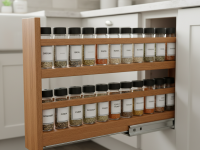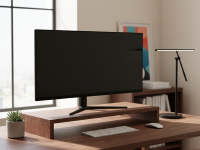Ever walked into a room and seen those stuing floating shelves that just seem to defy gravity? They look so sleek, so modern, almost like they’re just part of the wall, yet they hold your favorite books, plants, or decorative pieces with such grace. If you’re anything like me, you’ve probably thought, “Wow, I wish I could have those!” Well, guess what? You absolutely can! And the secret, my friends, lies in mastering the art of hidden brackets.
For years, I admired these shelves from afar, thinking they were some kind of magical, professional-only installation. But after one too many Pinterest rabbit holes and a desperate need for stylish storage, I decided to dive in. What I discovered was a project that, while requiring a bit of precision and patience, is incredibly rewarding and totally achievable for the average DIY enthusiast. This isn’t just a guide; it’s a peek into my own journey, full of lessons learned and “aha!” moments, to help you create your own seamless floating masterpieces.
Why Hidden Brackets Are a Game-Changer for Your Home
Let’s be real: traditional shelf brackets, while functional, often distract from the beauty of your decor. They can look clunky, collect dust, and just aren’t as visually appealing. Hidden brackets, on the other hand, offer an unparalleled aesthetic. They create a clean, minimalist look that makes your items appear to float, adding a touch of sophistication to any room. It’s not just about storage; it’s about elevating your space’s design.
My first attempt at floating shelves was with visible brackets, and while they served their purpose, I always felt like something was missing. The moment I switched to hidden brackets for my next project, the difference was night and day. The room instantly felt more polished, more deliberate. It’s like the difference between a good outfit and a perfectly tailored one – it just fits better, looks sharper, and makes a stronger statement.
Plaing Your Floating Shelf Project: Measure Twice, Dream Once
Before you even think about picking up a saw, meticulous plaing is your best friend. Trust me, I learned this the hard way with a shelf that ended up slightly off-kilter (a story for another time!).
1. Location, Location, Location!
- Where will they go? Consider the wall material. Drywall? Masonry? The type of wall dictates how you’ll secure your brackets. Always aim to hit studs if working with drywall – they’re your shelves’ best friends for stability.
- What’s the purpose? Are these decorative shelves for lightweight items or heavy-duty storage for books or dishware? This will influence your choice of wood and brackets.
- Aesthetics: How many shelves? What spacing? Use painter’s tape to mock up your layout on the wall. This visual aid is invaluable for getting the proportions just right.
2. The Weighty Matter: Capacity and Dimensions
This is crucial. Seriously, don’t skimp here. Overloaded shelves are a recipe for disaster. The total weight your shelf can hold depends on a few factors:
- Shelf thickness: Thicker wood is generally stronger.
- Shelf depth and length: Longer and deeper shelves can sag if not properly supported.
- Bracket type and number: More brackets, especially when hitting studs, equals more support.
- What you’ll put on them: Grab some of the items you plan to display and get a sense of their weight. Books are surprisingly heavy!
I typically aim for shelves at least 1.5 inches thick for a sturdy feel, especially if they’re holding anything substantial. For decorative items, 1 inch might suffice, but check your bracket specifications. As for length, I like to keep individual shelves under 4 feet if using just two brackets to minimize potential sag, unless I’m using exceptionally robust brackets or a very thick slab of wood.
3. Gathering Your Arsenal: Tools and Materials
You’ll need a few essentials. Don’t worry, most are standard DIY tools:
- For the shelves: Your chosen wood, a saw (miter saw for precise cuts, circular saw for longer cuts), sandpaper (various grits), wood filler (if needed), wood glue, and your preferred finish (stain, paint, polyurethane).
- For installation: Stud finder (non-negotiable!), level (long and short), drill and drill bits (paddle bits or Forstner bits for boring into the shelf, smaller bits for pilot holes in the wall), measuring tape, pencil, safety glasses, hidden shelf brackets.
- Optional but handy: Clamps, speed square, a good friend to help hold things!
Choosing Your Wood: Beauty Meets Brawn
The type of wood you choose impacts both the look and the longevity of your shelves. My personal go-to is solid wood – oak for its beautiful grain and durability, or maple for a cleaner, modern look. Pine is more budget-friendly and easy to work with, but might not offer the same rigidity for very long spans unless it’s quite thick.
- Solid Wood: Offers natural beauty, can be stained or painted, and is generally very strong. Just remember to factor in its weight!
- Plywood (with edge banding): A good option for deeper shelves or if you want to create a specific look by applying veneer or solid wood strips to the edges. Choose a high-grade plywood for strength and stability.
- MDF (Medium-Density Fiberboard): While cheaper and very smooth for painting, it’s not as strong or moisture-resistant as solid wood or plywood and might not be suitable for heavy loads or humid environments (like bathrooms). I’d personally steer clear of MDF for floating shelves with hidden brackets, as the integrity of the material where the brackets attach is paramount.
When selecting your wood, look for straight pieces with minimal warping or knots, especially if you’re staining them. The straighter the wood, the easier your build will be.
The Heart of the System: Selecting the Right Hidden Brackets
This is where the magic happens! Hidden brackets come in various forms, but for solid wood shelves, you’ll most commonly encounter:
- Solid Steel Rod Brackets: These are my favorite for a truly invisible look. They consist of long steel rods (typically 6-10 inches) that are anchored into your wall studs and then slide into precisely drilled holes in the back of your wooden shelf. They offer excellent support when properly installed.
- Plate or T-Brackets: These have a flat plate that mounts to the wall (again, preferably into studs) with protruding arms or a T-shaped profile that supports the shelf. The shelf then slides over these arms. They might be slightly more visible if your shelf isn’t deep enough to completely conceal the arm, but they’re very strong.
Always buy brackets that explicitly state their weight capacity. Don’t guess! And if your shelf is long, consider using three brackets for added support, especially for heavier loads.
The Build: From Raw Wood to Wall-Mounted Masterpiece
Okay, you’ve plaed, you’ve gathered, you’ve chosen. Now for the fun part – building and installing!
1. Prepare Your Shelves: Cut, Sand, Finish
First, cut your wood to the desired length and depth. Precision here is key. Next, sand, sand, sand! Start with a coarser grit (like 80 or 120) to smooth out any imperfections, then move to finer grits (180, 220) for a silky-smooth finish. Rounding off the edges slightly with a router or some extra sanding can give them a professional, softer look. Finally, apply your chosen finish. Whether it’s stain, paint, or a clear coat of polyurethane, do it before installation. It’s much easier to get an even finish when the shelf is flat on a workbench.
2. Drilling for the Brackets: The Shelf Side
This step requires accuracy. Measure and mark the exact points on the back edge of your shelf where the bracket rods will enter. These marks need to align perfectly with where your wall-mounted brackets will be. Use a drill press if you have one – it guarantees perfectly straight holes. If you’re using a hand drill (like I usually do), use a drill guide or create a jig to ensure your drill bit goes in perfectly straight and level. Any deviation here will result in a crooked or ill-fitting shelf. Use a paddle bit or Forstner bit that matches the diameter of your bracket rods. Drill deep enough to accommodate the full length of the rod, minus about half an inch to ensure it sits snugly against the wall.
3. Wall Prep is Key: Finding Those Studs!
This is the most critical part for a secure floating shelf. Grab your stud finder and meticulously locate at least two, preferably three, wall studs where your shelf will be. Mark them clearly with a pencil. Use a long level to draw a perfectly straight line across the studs where the bottom of your shelf will sit. This line is your reference point.
4. Installing the Brackets to the Wall
Now, align your first bracket with your marked stud and the level line. Pre-drill pilot holes through the bracket’s mounting holes into the stud. This prevents splitting and makes driving screws easier. Secure the bracket firmly with appropriate screws (long enough to penetrate well into the stud – typically 2.5-3 inches). Repeat for the remaining brackets, ensuring they are perfectly level with each other and align precisely with the holes you drilled in the back of your shelf. This step can feel like a game of inches, but it’s worth the extra effort for a truly level and secure shelf.
5. Attaching the Shelves: The “Aha!” Moment
With your brackets securely installed and level, it’s time for the moment of truth! Carefully slide your finished wooden shelf onto the protruding rods. It should be a snug fit, requiring a gentle push. If it’s too tight, you might need to slightly enlarge your holes or gently sand the inside. If it’s too loose, your holes might be too big, or your brackets aren’t perfectly aligned – this is why precision earlier was so important! Many hidden brackets also have a small set screw on the underside that you can tighten to further secure the shelf to the bracket, preventing it from sliding off. This is a great feature for peace of mind.
Troubleshooting and Common Pitfalls (Learnings from Experience!)
- Slightly Crooked Shelf: If your shelf isn’t perfectly level, it’s likely due to bracket installation. Sometimes a slight adjustment to a bracket or shimming a bracket ever so slightly can correct it. Another common cause is holes drilled at a slight angle into the shelf itself. This is why a drill press or a very steady hand with a jig is invaluable.
- Shelf Wobbles: This usually means your brackets aren’t adequately secured to the wall, or you haven’t hit studs firmly. Go back and re-check those screws and stud locations. Don’t rely on drywall anchors for heavy floating shelves; they simply won’t hold the weight over time.
- Damage to the Wall: Be careful not to over-tighten screws when installing brackets, especially into drywall (even if you hit a stud, you don’t want to deform the drywall surface).
Finishing Touches and Styling Your New Shelves
Congratulations! You’ve successfully built and installed stuing floating shelves. Now comes the fun part: styling them! Think about balance, color, and texture. Don’t overcrowd them. A few thoughtfully chosen items – a trailing plant, a stack of books, a piece of art, or a cherished souvenir – will truly make your shelves shine. The clean lines of the floating shelves provide the perfect backdrop for your personality to come through.
My first set of hidden bracket shelves transformed a bland wall in my home office into a functional and beautiful display. Every time someone asks how I got them to “float,” I get a little thrill from sharing the DIY secret. It’s a project that builds confidence along with beautiful storage.
Conclusion
Building floating shelves with hidden brackets might seem intimidating at first glance, but with careful plaing, the right tools, and a healthy dose of patience, it’s an incredibly rewarding DIY project. Not only will you save money, but you’ll also gain immense satisfaction from creating something beautiful and functional with your own hands. So go ahead, embrace the challenge, and transform your walls with the effortless elegance of floating shelves. You’ve got this!
1. A modern living room with pristine white walls featuring three elegant, light-colored wooden floating shelves installed above a minimalist console table. The shelves are neatly styled with a mix of books, a small potted plant, and abstract art pieces, highlighting their seamless, bracket-free appearance.
2. A close-up shot of a person using a hand drill with a large Forstner bit to precisely drill a deep, straight hole into the back edge of a long, sanded wooden shelf, preparing it for hidden steel rod brackets. The wood is a warm, natural tone.
3. A wall section with several heavy-duty, L-shaped steel hidden shelf brackets securely mounted directly into visible wooden wall studs. The wall is drywall, and the brackets are level and evenly spaced, ready to receive a wooden shelf.
4. A pair of hands carefully sliding a beautifully finished, medium-toned wooden shelf onto two previously installed hidden steel rod brackets protruding from a white wall. The shelf is almost fully in place, showcasing the flush, floating effect.



